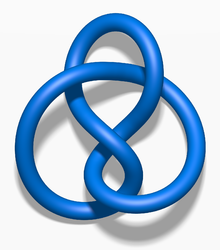Hyperbolic knot
In knot theory , a branch of mathematics , hyperbolic knots form by far the largest class of knots .
definition
A node is called hyperbolic if its complement is a hyperbolic manifold , i.e. if it carries a complete Riemannian metric of finite volume of the sectional curvature constant −1.
More generally, a link is defined as hyperbolic if its complement is a hyperbolic manifold.
characterization
A node is hyperbolic if and only if it is not a torus node or a satellite node .
Of the 1,701,936 prime nodes of the intersection number less than or equal to 16, 1,701,903 are hyperbolic, i.e. more than 99.99%.
Invariants
From Mostow's theorem of rigidity it follows that a complete hyperbolic metric of finite volume on a node complement is uniquely determined except for isometry. Therefore geometric invariants of the hyperbolic metric then give topological knot invariants .
In particular, the hyperbolic volume has been found to be a useful invariant for measuring the complexity of nodal complements. Other geometrically defined invariants are the Chern-Simons invariant and the length spectrum .
The hyperbolic knot of smallest volume is the figure eight knot with a volume of 2.0298 ...
Hyperbolic Stretching Surgery
The approach to knot theory by means of hyperbolic geometry developed as a special case of Thurston's approach to the topology of 3-manifolds by means of geometrization .
Thurston used the deformation theory of incomplete hyperbolic metrics on nodal complements to prove that almost all stretching surgeries on a hyperbolic node give a closed hyperbolic manifold ( hyperbolic stretching surgery ).
software
The SnapPea program finds the hyperbolic structure on a node complement (if it exists) and calculates geometric invariants such as the volume, the Chern-Simons invariant and the isometric group .
literature
- Colin Adams, The Knot Book , Spectrum Academic Publishing House (1995), ISBN 978-3860253380
- William Thurston, The geometry and topology of three-manifolds , Princeton lecture notes (1978-1981). on-line
- Jessica Purcell, Hyperbolic Knot Theory . on-line
Web links
- Hyperbolic Knot (MathWorld)
- Hyperbolic Knots (Handbook of Knot Theory)
- Makoto Sakuma: A survey on the impact of Thurston's work on knot theory

